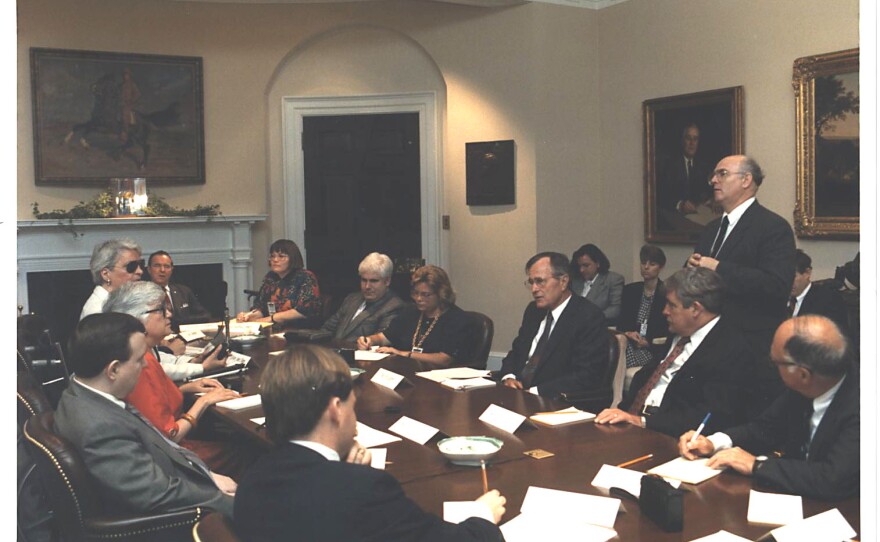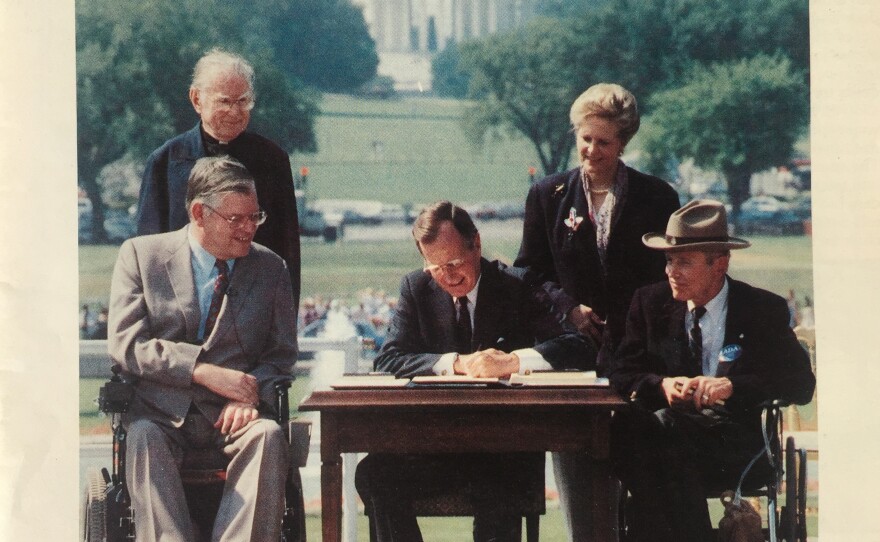It’s a new day along San Diego’s harbor: detached tables and chairs make it easy for anyone in a wheelchair to have a place at the table and watch the ships and boats cruise by.
The recent makeover of San Diego’s downtown waterfront was designed with convenience for everyone in mind.
Bill Stothers, a member of the Accessibility Advisory Committee to the San Diego Unified Port District, helped come up with the some of the ideas. Bill and his wife, Cyndi Jones, remember when access was not a part of architectural design, when ignorance and barriers stood in the way of people with disabilities. The two have spent a lifetime trying to change that.

In 1983, Jones was out grocery shopping when something caught her attention. It was a Wheaties cereal box announcing a search for a new athlete to grace the cover.
After looking through the rules, Jones called the head of the Wheelchair & Ambulatory Sports, USA (then called the National Wheelchair Athletic Association) to recommend an athlete with a disability.
“I said, ‘you know we could get a wheelchair athlete on the front of a Wheaties box.’ ”
Before long, George Murray, a two-time Boston Marathon wheelchair champion was selected from a pool of more than 6,000 entrants.
Jones said the following summer, Murray appeared on three million of the iconic orange cereal boxes.

“I get goose bumps thinking about it because how many mothers who had disabled kids saw that and saw that their kid could get into sports,” she said.
Cyndi Jones and Bill Stothers, who both survived polio, have seen lots of changes in their lifetime. Some of these changes were due, in part, to the1977 White House Conference on Handicapped Individuals.
“There weren’t many regulations then, and there was not a lot of access. It hadn’t been done yet,” Jones recalled.
“Coming out of the conference there was a greater sense of national identity. It awakened a consciousness. Different strands came together at the White House conference and then spread out again throughout the country, kind of reenergized and from there on, there was a succession of laws,” Stothers said.
The White House Conference on Handicapped Individuals was also where Cyndi Jones and Bill Stothers first met.

Jones would later be invited back to the White House to witness the signing of the Americans with Disability Act.
“The signing was a celebration among the least powerful group in America, a living example of what we can all do if we work together and are in it for the long haul. I imagined this breeze beginning in Washington, gathering strength as it blew across Appalachia, all the way to California and beyond,” she said.
On The Media
Jones and Stothers' work together includes changing perceptions and coverage by the media.
It started when they took ownership of Mainstream Magazine in November of 1984.
“We wanted to engage the wider disability community on issues that needed to be addressed,” Jones said.

When they acquired the magazine they also switched the company from a non-profit to a for-profit company.
“One of the goals was to confront the stereotype that people with disabilities are dependent and reliant on government services. We wanted to demonstrate that disability could operate in the marketplace on its own two feet,” Stothers said.
The magazine started locally and later went international with a readership of 50,000, covering issues ignored by the mainstream media, from large demonstrations, with hundreds of people in wheelchairs, to products for daily living.
As advertisers' budgets started to shrink, the magazine also started to wane. When a grant to explore research about how people with disabilities live became available, Jones and Stothers used it to engage with reporters.
“People don’t understand disability as a civil rights issue, the general population thinks of it as an individual issue,” Jones said.
They also used the funding to increase news coverage on disability issues and to transform the coverage to something more substantive, instead of what Bill called “inspiration porn,” remembering a newspaper story about a woman with a disability getting married.
“Look at how wonderfully this disabled person is doing,” Stothers recalled. “It made my eyes roll."
What's Next
Stothers and Jones later also started the "What's Next?" Mentoring Program, matching up adults with disabilities and youth to help the younger generation gain independence.

“It was an eye opener for parents and the kids that they could grow up to go to school, get an education and live independently,” Stothers said.
Mentors were people with disabilities who were living independent, successful lives. Activities included living at UC San Diego for a week, taking classes, organizing daily care, and instruction on how to use public transportation.
“It goes back to trying to help the next generation move forward,” added Jones.
Stothers says a lot of work remains undone and is still working to raise awareness about the hundreds of thousands of people in the U.S. living with the effects of polio.
“I hear people say, 'I never see anyone with a disability.' But it all works together, the more curb cuts, the more people can get around; and when programs are designed to say we have higher expectations of kids with disabilities, the more people see people with disabilities, and the more inclusive the community becomes."





